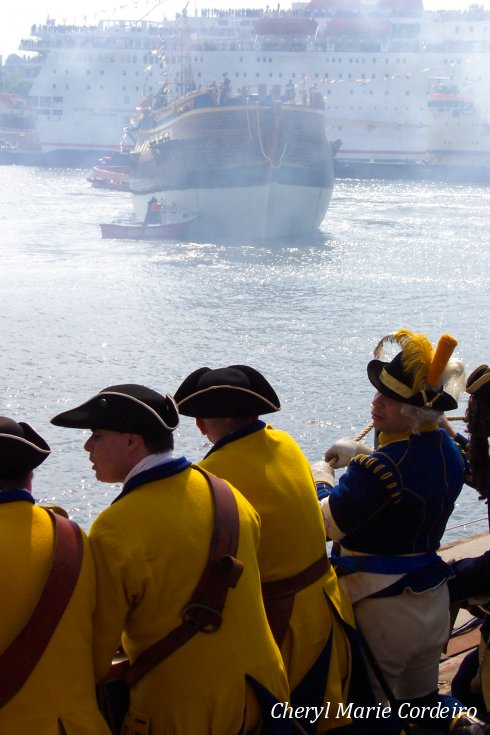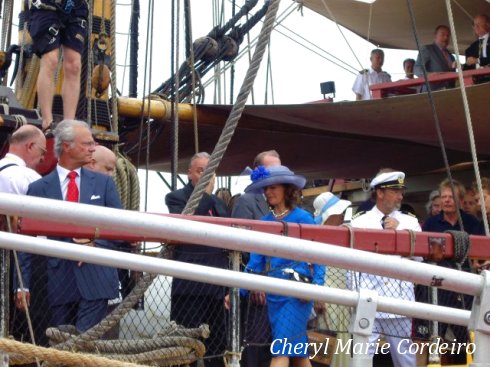In 2003, launching of the Swedish East Indiaman Gotheborg III
Photo © JE Nilsson and C M Cordeiro-Nilsson for CMC 2003-2011
My personal involvement in the Swedish East Indiaman Gotheborg III project was so early that I had not myself realized it back then. In the project newspaper GotheborgsPosten that was distributed in 360,000 copies throughout the entire western Sweden in 1996, it was outlined that one of the research objectives that would be targeted was Swedish-Chinese Business Communication. The Professor that in 2003 would arrange for me to receive the Anna Ahrenberg Research Funding Scholarship to help me start a PhD research (graduated in 2009) in doing precisely that, was interviewed. Strange indeed are the paths of life. Today, I go off to work everyday by ferry straight across Wargö Håla, the historic departure point of the Swedish East Indiamen in the western Swedish archipelago. In fact the house in which we live features one of the ship’s actual water provision wells in our very garden.
Currently at work, at the University of Gothenburg School of Executive Education AB, prevalent topics of discussion circle around Swedish-Chinese business relations and the future of work prospects with Sweden’s competitive growing economy that earned acknowledged nods from Swedish leaders, specifically that of its Finance Minister, Anders Borg, of the country being a Nordic tiger economy (ref. Di, DagensPS and Epoch Times). All this showing that the Swedish East Indiaman still has a relevant role to play, more so today than ever in its importance of growing global contacts. Its shared goodwill initially created by the East Indiaman Project is everywhere present.
In the media recently, a passionate discussion has arisen about what to do with the ship, now when its initiating ideas have been completed – the ship built and it has traveled to China and back. What now?
Many suggestions including turning it into a museum, an amusement park and why not – firewood – have come forth. Personally not even at today’s energy prices does the idea of firewood sound very brilliant.
Eventually, the original Founders of the project have chosen to step forth, and in this weekend’s local newspaper GP, have briefly presented their views of how the ship could continue to earn its keep and do much more than that.
The following article were published in GP, in January 22, 2011, as part of the ongoing debate about the future of the Swedish East Indiaman Gotheborg III ship.
H.M. King Carl XVI Gustaf and H.M. Queen Silvia, disembark the Gotheborg III in Canton, China, 2006.
From the point of view of Anders Wästfelt and the Think Tank Gotheborg, the ship is far from done sailing:
“In view of the past few days defensive debate in the media and our City Council, on the future of the East Indiaman Gotheborg, it is time to lift our eyes beyond the horizon. In the right hands the Götheborg III – our ship – is a regional and national asset with huge potential.
She has great future tasks, functioning as a symbol of our community, an inspiration for continued work and as a source of financial revenues. She is well-built and with proper maintenance, she can sail for another 20-30 years.
The project to build a replica of the 1700s Swedish East Indiaman began in 1992 as a private initiative. It was well thought through and enjoyed the support of international shipbuilding expertise, the best marketing specialists, lawyers, economists, politicians, sinologists, university faculties as well as members of the Swedish Ministry of Foreign Affairs and the Swedish Trade Council.”


One thought on “The Swedish East Indiaman Gotheborg – and the tiger economy of Sweden”
Comments are closed.